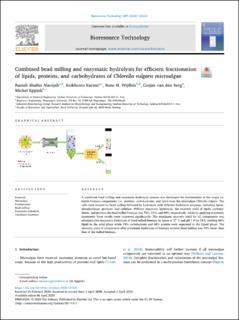Combined bead milling and enzymatic hydrolysis for efficient fractionation of lipids, proteins, and carbohydrates of Chlorella vulgaris microalgae
Alavijeh, Razieh Shafiei; Karimi, Keikhosro; Wijffels, Rene Hubertus; van den Berg, Corjan; Eppink, Michel H.M.
Peer reviewed, Journal article
Published version

View/
Date
2020Metadata
Show full item recordCollections
Original version
Alavijeh, R. S., Karimi, K., Wijffels, R. H., van den Berg, C. & Eppink, M. (2020). Combined bead milling and enzymatic hydrolysis for efficient fractionation of lipids, proteins, and carbohydrates of Chlorella vulgaris microalgae. Bioresource Technology, 309: 123321. doi: 10.1016/j.biortech.2020.123321Abstract
A combined bead milling and enzymatic hydrolysis process was developed for fractionation of the major valuable biomass components, i.e., proteins, carbohydrates, and lipids from the microalgae Chlorella vulgaris. The cells were treated by bead milling followed by hydrolysis with different hydrolytic enzymes, including lipase, phospholipase, protease, and cellulase. Without enzymatic hydrolysis, the recovery yield of lipids, carbohydrates, and proteins for bead milled biomass was 75%, 31%, and 40%, respectively, while by applying enzymatic treatments these results were improved significantly. The maximum recovery yield for all components was obtained after enzymatic hydrolysis of bead milled biomass by lipase at 37 degrees C and pH 7.4 for 24 h, yielding 88% lipids in the solid phase while 74% carbohydrate and 68% protein were separated in the liquid phase. The recovery yield of components after enzymatic hydrolysis of biomass without bead milling was 44% lower than that of the milled biomass.
